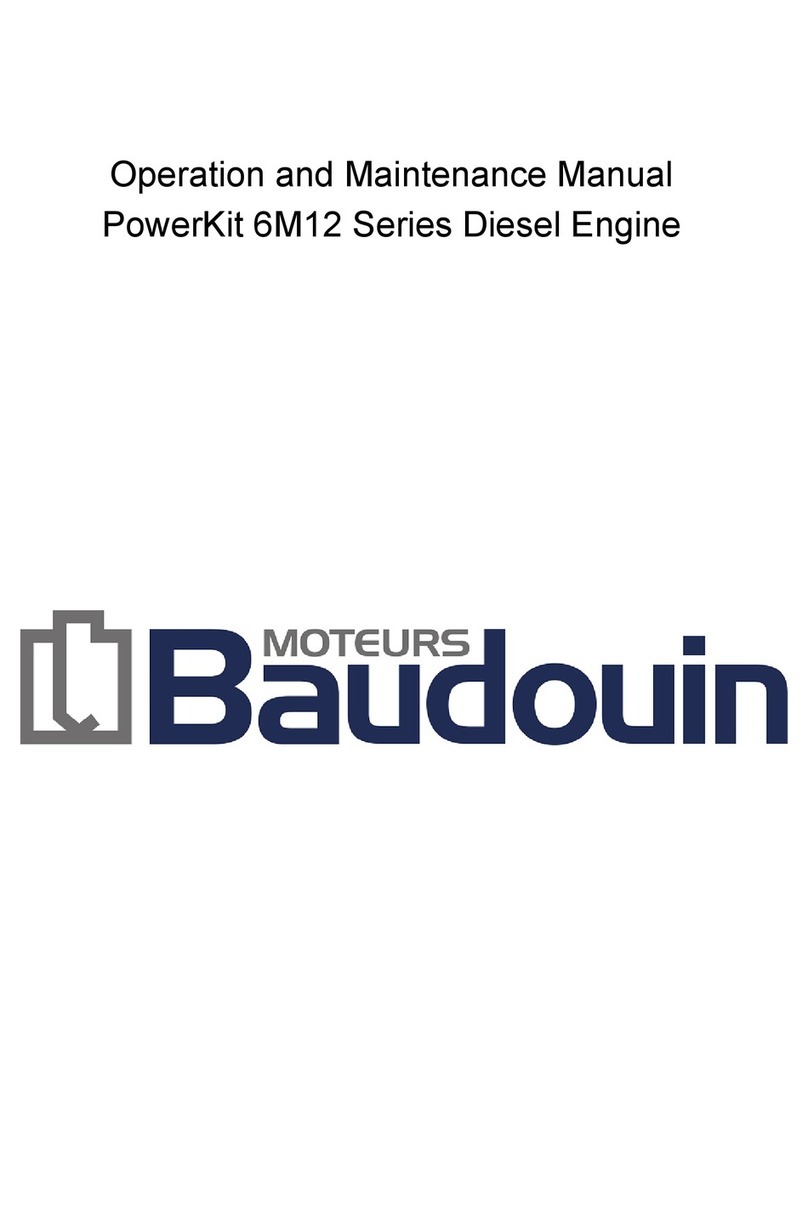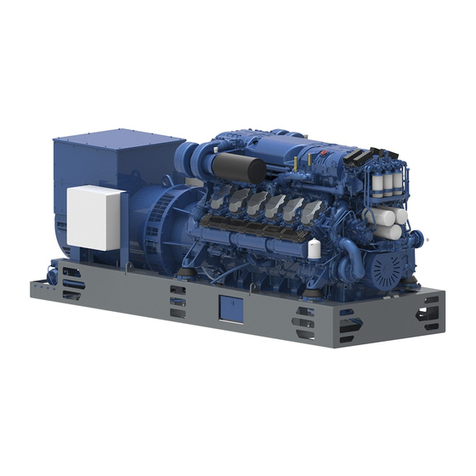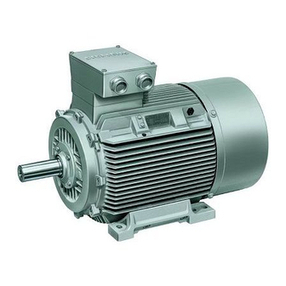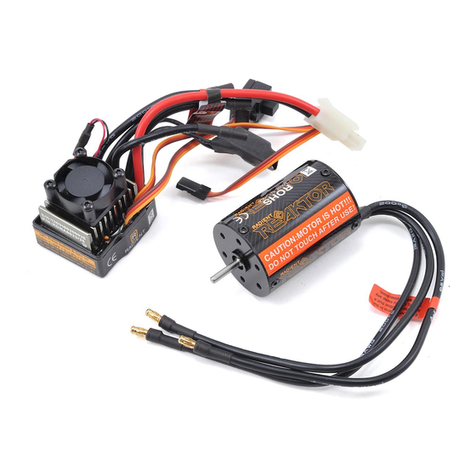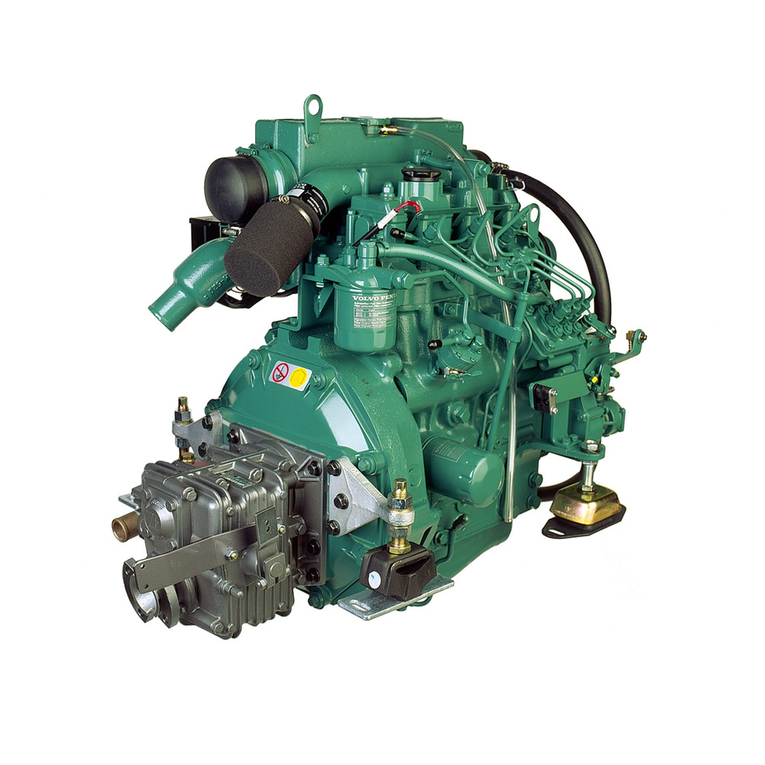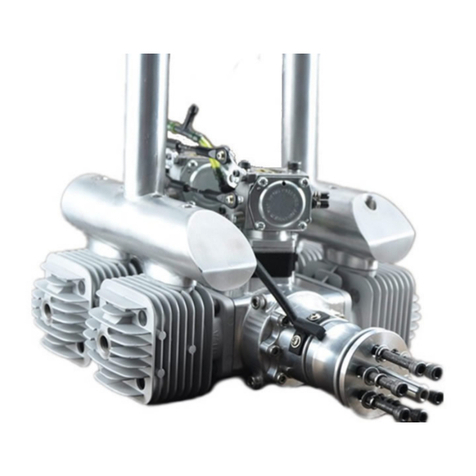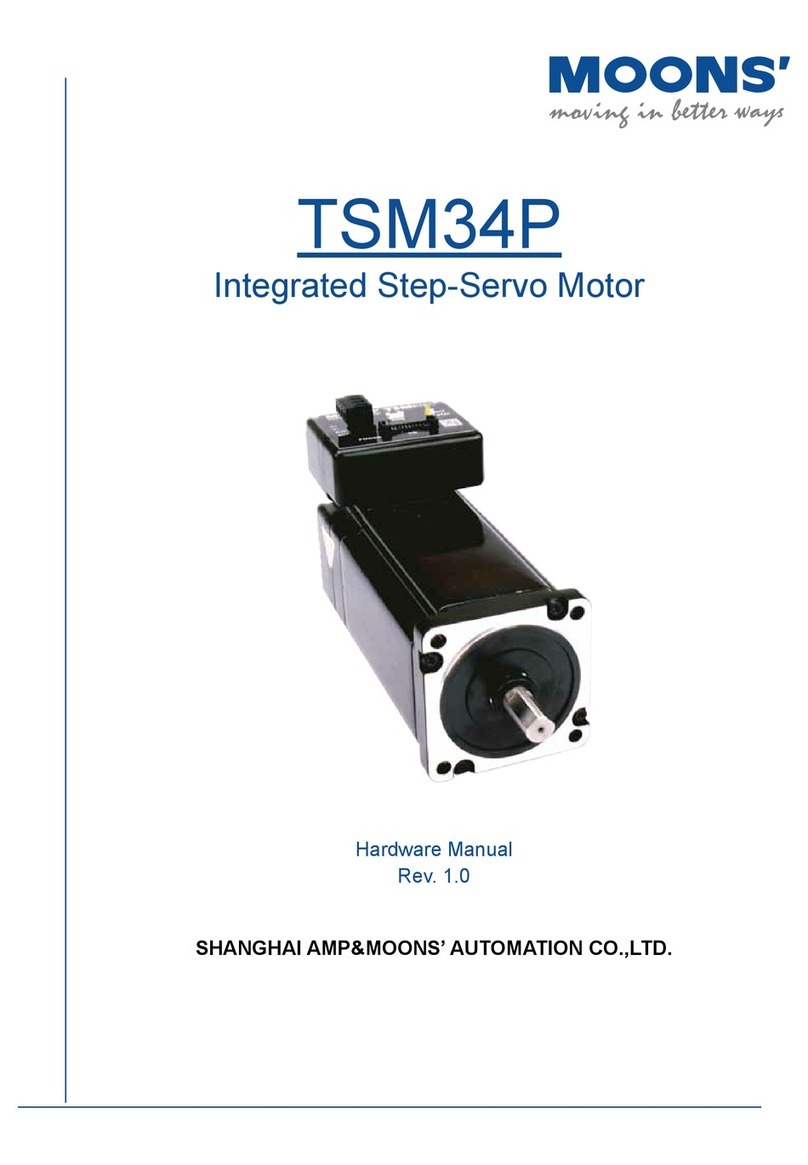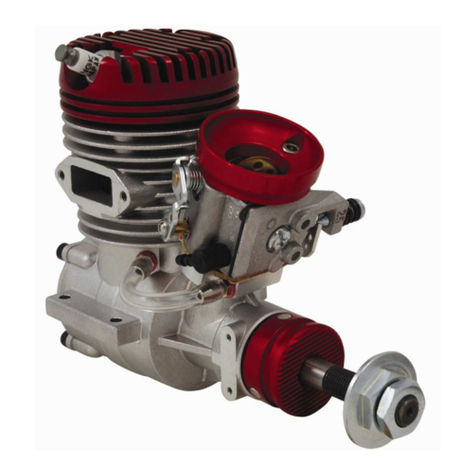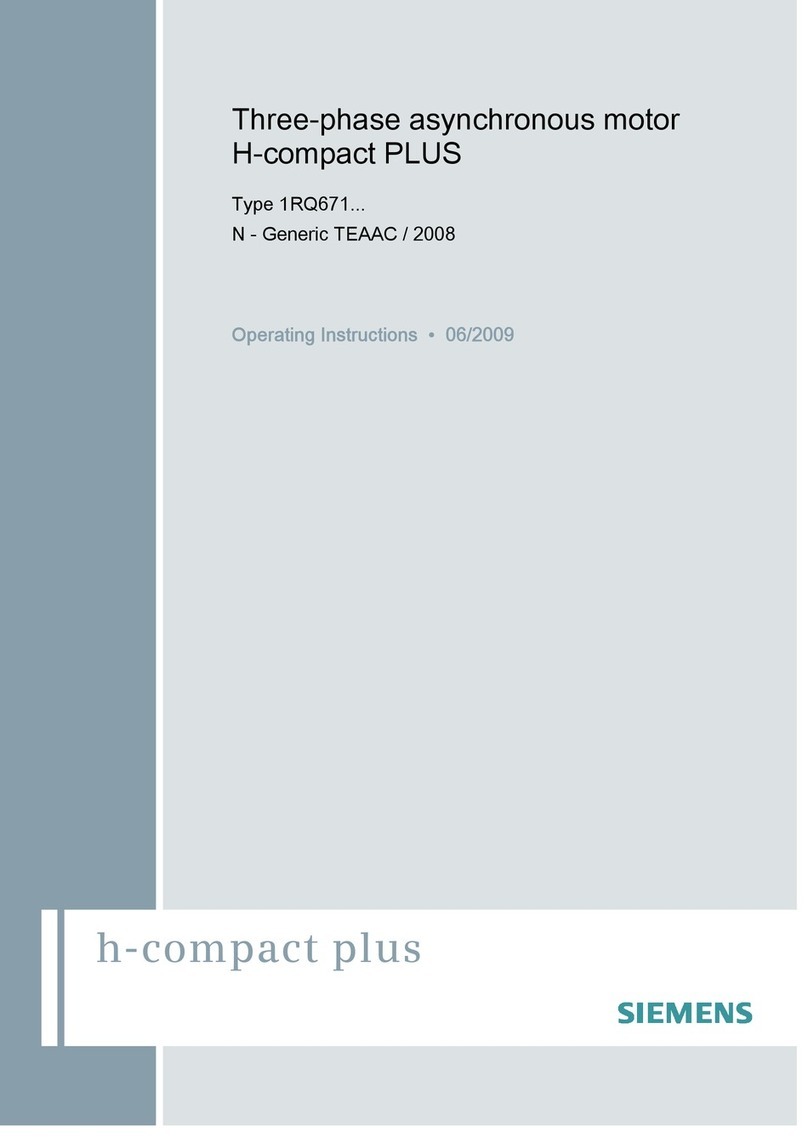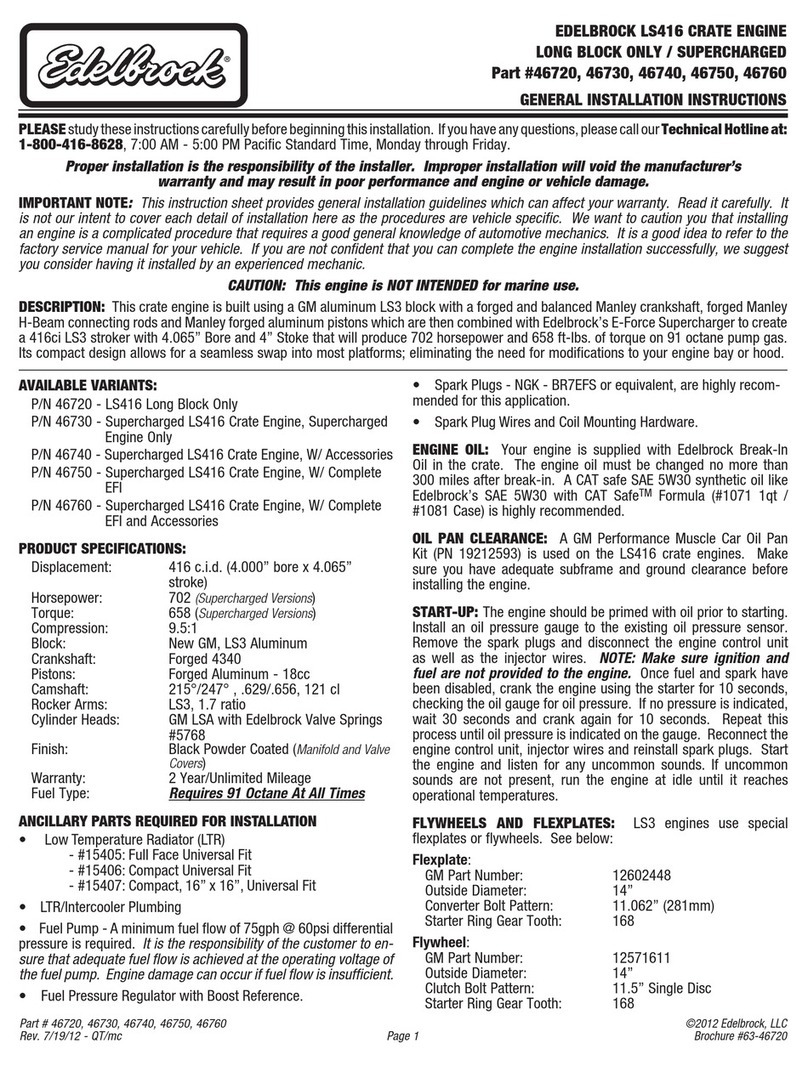Baudouin 6M33NG User manual

1

2
Operation and Maintenance Manual for
6M33 Series PowerKit Gas Engine
OMMBV2007

Foreword
3
Foreword
Please be advised, do not operate or
perform any operation, maintenance, or
repair on this PowerKit engine until you have
read and understood the information in this
Manual in its entirety. This Manual must be
read in full before operating your PowerKit in
order to gain the maximum operational
performance of the engine and to safely
operate and maintain the engine. The
operation and maintenance instructions are
given as a guide for engines operating at the
rating as sold.
Documentation
Baudouin uses English as the primary
business language for all publications. Other
languages may be available, please consult
with your local Baudouin representative.
The photos and illustrations in this manual
are for reference only. Some illustrations
may have been modified to ensure clarity
(for example guards and covers may be
removed), and some equipment shown in
this manual may be different to your engine.
For the latest information, please contact
your local Baudouin representative.
The 'DT' technical documents
('documentation technique') quoted in this
Manual are available from the Baudouin
Network for reference.
The information contained in this Manual is
correct at the time of publication. Baudouin
reserves the right to modify these
specifications without notice.
Safety
The Safety section of this manual covers
basic safety precautions and shows
warnings and potentially hazardous
situations. This Manual must be read in full
before operating your PowerKit in order to
operate and maintain the engine safely.
Maintenance & Spare Parts
Maintenance should be carried out at the
appropriate intervals as shown in the
Maintenance Table. The inspection and
maintenance intervals are given as a guide,
for engines operating under normal
conditions. Consult with your Baudouin
representative for operation under severe
conditions.
We recommend that a copy of the
Maintenance Schedule be displayed near
the engine and that a service record be kept
and stored with the engine.
The use of Baudouin Genuine Spare Parts is
imperative to the optimal operation,
performance and longevity of your PowerKit
engine. The use of alternatives or counterfeit
parts can lead to voiding engine warranty,
damage, failures, and personal injury or
death.
Overhaul
This Manual does not include instructions for
major overhaul of your engine. Contact your
local Baudouin representative who can help
you to define an overhaul program for your
engine. All major repairs should be carried
out by an authorized Baudouin partner.

Content
4
Foreword..............................................................................................................................3
1. Safety...............................................................................................................................6
1.1 Safety Information........................................................................................................ 6
1.2 Symbols Used .............................................................................................................. 7
1.3 Personal Safety.......................................................................................................... 10
1.4 Environmental Safety................................................................................................. 10
1.5 Fluid Safety .................................................................................................................11
1.6 Batteries ......................................................................................................................11
1.7 Welding....................................................................................................................... 12
1.8 Electrical Risks........................................................................................................... 13
1.9 Lines, Tubes and Hoses............................................................................................. 14
1.10 Coolant Safety.......................................................................................................... 14
1.11 Cleaning the Engine ................................................................................................. 15
1.12 General Precautions for Operation .......................................................................... 16
2. Product...........................................................................................................................18
2.1 Rating Definitions ....................................................................................................... 18
2.2 Engine Model ............................................................................................................. 19
2.3 Engine Overview........................................................................................................ 22
2.4 Cooling Circuit............................................................................................................ 24
2.5 Lubrication System..................................................................................................... 26
2.6 Gas Supply System.................................................................................................... 27
2.7 Electronic Control Unit (ECU) and Electronic Parts Introduction ............................... 29
3. Installation......................................................................................................................33
3.1 Engine Lifting.............................................................................................................. 34
3.2 Engine Mounting ........................................................................................................ 36
3.3 Accessories ................................................................................................................ 37
3.4 Air Intake System ....................................................................................................... 38
3.5 Exhaust System ......................................................................................................... 38
3.6 Cooling System .......................................................................................................... 39
3.7 Lubrication System..................................................................................................... 39
3.8 Gas Supply System.................................................................................................... 40
3.9 Engine Electronic System .......................................................................................... 41
3.10 Engine Electronic Controlling System...................................................................... 42
3.11 Gen Set Installation Recommendation..................................................................... 45
4. Operation.......................................................................................................................46
4.1 Preparations before Start........................................................................................... 47
4.2 Starting Up ................................................................................................................. 49
4.3 Operation of the PowerKit Engine.............................................................................. 50
4.4 Precautions for running in cold environments............................................................ 51
4.5 Stopping the PowerKit Engine ................................................................................... 52
4.6 Electronic control system ........................................................................................... 53
5. Maintenance ..................................................................................................................54
5.1 General Safety Conditions for Maintenance .............................................................. 54
5.2 Maintenance Table ..................................................................................................... 55

Content
5
5.3 Maintenance Operations............................................................................................ 59
5.4 Storage Protection Instruction.................................................................................... 76
6. Appendix........................................................................................................................82
6.1 Coolant Recommendation.......................................................................................... 82
6.2 Lubricant Oil Recommendation.................................................................................. 83
6.3 Gas Recommendation................................................................................................ 85
6.4 Baudouin Special Tools.............................................................................................. 86
6.5 Common Faults and Troubleshooting........................................................................ 89
6.6 Maintenance Log........................................................................................................ 97
Index ................................................................................................................................100

Safety
6
1. Safety
1.1 Safety Information
Failure to comply with the preventive measures and safety instructions included in this manual
and with warnings indicated on the engine may lead to injury or death. This Operation and
Maintenance Manual must be kept on or near the engine and must be easily accessible and
ready to be consulted at any time. Furthermore, this manual must stay with the engine at all
times.
Most accidents can be prevented by following basic safety precautions, recognizing hazardous
situations and acting accordingly, but these safety instructions alone are not sufficient to avoid
every hazard. Baudouin cannot anticipate or identify every possible hazard in your operating
environment. Persons operating or maintaining the engine must be able to recognize
hazardous situations, and they must have the necessary skills, training and tools to perform
operation and maintenance activities properly.

Safety
7
1.2 Symbols Used
Please take note of the warnings and precautions indicated throughout this Manual in order to
avoid unsafe practices and conditions. In this Manual, the following symbols are used to
highlight specific information.
HAZARD WARNING
This warning symbol is recognized across
the world. In this Manual this symbol is used
to highlight the importance of the information
that follows. Make sure that you understand
the consequences of a dangerous situation
and the ways in which to avoid danger.
Fail-ure to comply with warnings can result
in material damage, serious injury or even
death.
WARNING
This type of warning indicates a potentially
dangerous situation, which if not avoided,
may result in serious injury, death, or
considerable material damage.
CAUTION
This type of warning indicates a potentially
dangerous situation, which if not avoided,
may result in minor injury or material
damage. It can also warn against dangerous
practices.
The warnings in this guide cannot cover every situation imaginable. Please only use
procedures, methods, tools, and parts specially recommended by the engine manufacturer.

Safety
8
Safety symbols
Symbol
Definition
Wear hand protection
Wear ear protection
Wear eye protection
Wear head protection
Wear foot protection
Wear a protective mask
Wear overalls
Avoid naked flames
Do not smoke
Do not use a mobile phone
Keep an extinguisher close by
Danger: battery acid
Danger: live cables, electrical risks
Highly flammable products
Keep away from hanging loads
Risk of thermal burns
Risk of mechanical drive / rotating parts
Lifting is forbidden
Risk of steam burns
Water drain valve

Safety
9
Universal Warning
The location of the Universal Warning label is illustrated below.
6M33 Gas Engine Series
Figure 1.2B- 6M33 Gas Engine Illustration
Do not operate or perform maintenance on this engine unless you have
read and understand the instructions and warnings in this Operation and
Maintenance Manual. Failure to follow the instructions or heed the
warnings could result in serious injury or death.

Safety
10
1.3 Personal Safety
These Personal Safety precautions are designed to reduce the risk of contamination, serious
injury or death.
Wear personal protective equipment (PPE) as required.
Avoid prolonged and repeated contact with oil.
Do not put oily rags in pockets.
Avoid contaminating clothing with oil.
Wash overalls regularly. Throw away un-washable clothing and shoes impregnated with
oil.
Emergency treatment must be immediately sought in the event of any injury.
Always wear protective mechanic's gloves before working in order to avoid prolonged and
repeated contact with oil.
Wash with soap and hot water or, alternatively, use hand detergent and a nailbrush to
make sure that all oil is removed. Products containing lanolin can help replace the skin's
natural oils that may have been removed.
DO NOT use petrol, kerosene, fuel, thinners or solvents to clean the skin.
If skin problems occur, immediately consult a doctor.
If possible, degrease components before handling them.
When there are risks for the eyes, use safety glasses or a face shield. An eye-rinsing
solution must be kept close at hand.
Do not spill oil or other fluids on the ground when repairing the engine. In the event of an
accidental spillage of hydrocarbon or other fluid, take all the necessary measures to
section off the area, clean up and protect people and the environment.
The handling, storage and recycling of hydrocarbons, ethylene, glycol and oil must
comply with the safety and environmental standards applicable in the country where
these operations take place.
Ensure that all guards and covers are secured in place on the engine.
Make sure adequate, non-expired extinguishers are available and that personal are
adaquately trained in extinguisher operation.
1.4 Environmental Safety
There are laws regarding environmental protection and the disposal of waste of
hydrocarbons. To ensure compliance with environmental protection laws, consult your
local authorities who will advise you. Obey all local regulations for the handling and
disposal of liquids.
The products and spare parts supplied by Baudouin do not contain asbestos.

Safety
11
1.5 Fluid Safety
All oil, natural gas, and some coolant
liquids are flammable. If these liquids
and gas are leaking onto hot surfaces
they can cause a fire which can cause
injury and/or damage.
Do not check for leaks using any body
part. Use a cardboard section or other
appropriate tool to check for a leak.
Store all gas and lubricants in closed,
clearly labelled containers in a safe
place.
When draining liquids from the engine,
ensure that the correct tools are used
and that liquids are collected in a
suitable container and disposed of
following all local regulations.
Oily rags and other flammable materials
must not be stored in close proximity to
engine, genset, or system.
Do not smoke near the fuel tank or
while in the filling area. Ensure there
are no open flames or sparks. Always
stop the engine before refuelling.
Mobile phones (in particular their
batteries) may give off sparks that could
cause an explosion in certain high-risk
areas. Switch off all mobile phones
when filling the gas tank or while in the
filling area.
1.6 Batteries
Wear personal protective equipment
(PPE) as required.
Do not smoke in areas where batteries
are charged or near fuel circuits.
The batteries release flammable fumes
that can explode. Ensure there are no
open flames or sparks near the battery.
If the batteries are in a closed area,
make sure there is sufficient ventilation.

Safety
12
The battery cables must be fitted with a
battery switch and fuse or circuit
breaker to isolate the circuit.
Sulphuric acid contained in batteries is
toxic and corrosive; it can burn clothes
and skin or even cause blindness in
case of contact with the eyes.
Disconnect the batteries before any
operation involving the electrical
system.
Never disconnect any battery cable
while the engine is operating.
Never check battery charge by short
circuiting it.
Do not charge a frozen battery; heat it
up 16°C (61°F) beforehand.
In the event of corrosive material
contact with a body part:
Rinse the affected part with plenty
of water.
Apply bicarbonate of soda or lime
to neutralise the acid.
Rinse your eyes for 10 to 15
minutes.
See a doctor immediately.
In the event of ingestion see a doctor
immediately.
Make sure the batteries are clean and
fitted with the recommended covers,
cables and connections.
Electric wiring must be kept in good
condition, properly positioned and
attached.
1.7 Welding
Do not weld or flame cut pipes, hoses
or tanks that contain flammable fluids.
Components containing flammable
fluids must be drained and cleaned
appropriately with a non-flammable
solvent before conducting any welding
of flame cutting.
Disconnect the engine wiring harness

Safety
13
before welding (control cabinets,
electrical cabinets etc.).
Comply with all legal provisions in force
before conducting welding work.
Do not use open fires.
Make sure that the work will not affect
the on-board electrical and electronic
equipment.
Make sure that the automatic fire
suppression system is deactivated
before any welding or grinding work.
Make sure that there is sufficient
ventilation in the premises where
welding is to be carried out.
1.8 Electrical Risks
Electrical checks must be carried out
regularly.
Electric wiring must be kept in good
condition, properly positioned and
soundly attached.
All wires should be of the
recommended size.
Wires and cables must be protected by
a fuse or calibrated circuit breaker.
Do not short-circuit fuses and/or circuit
breakers.
The electrical circuit of the engine must
be isolated from the engine and
generator.
Ensure that the engine is grounded
correctly to prevent uncontrolled
electrical circuit paths which can cause
damage.
Insulation problems can cause short-
circuits or stray current. Stray current
can damage electrical and electronic
components, bushing or crankshaft
seating and may also cause ra-
dio-frequency disturbance.
The engine earth must be properly con-
nected to the chassis, as well as all the
flexible hoses.

Safety
14
Flexible connections for cooling
Flexible circuit connections fuel
Electrical control systems and
electronic fuel injection
Earth faults can cause corrosion in the
pipes and engine or genset unit compo-
nents.
1.9 Lines, Tubes and Hoses
Ensure that all high pressure lines are
not bent, worn or damaged. High
pressure lines must be positioned,
supported and firmly fastened. Do not
attach any other components to the
high pressure lines. Tighten all
connections to the recommended
torque.
Do not check for leaks using your hand.
Use a cardboard to check for a leak.
Tighten all connections and filter
housings to the recommended torque.
Release the lubrication, fuel and
pressure cooling circuits before
disconnecting or removing hoses or
associated parts.
1.10 Coolant Safety
At operating temperature, the coolant is
hot and pressurized. When pressure is
released sharply, this hot liquid may be
transformed into fumes. Any contact
with this hot liquid or these fumes may
cause serious burns.
The cooling system also contains alkali
which can cause injury. Do not allow
alkali to contact your skin, eyes or
mouth.
Let the components of the coolant
circuit cool down before draining the
circuit.
Only check the coolant level when the
engine has stopped.

Safety
15
Slowly unscrew the coolant filler plug to
release pressure.
1.11 Cleaning the Engine
Use personal protective equipment
when cleaning an engine.
Regularly clean the engine surface to
remove any greasy deposits that may
be flammable.
Do not wash an engine in operation or
which has just stopped.
Use the safety equipment required by
your local codes and standards.
Make sure high-pressure water cannot
damage the equipment being washed.
Do not get electrical equipment or seals
wet.
Take necessary precautions when
using a high-pressure cleaner. Comply
with the safety instructions indicated for
the cleaning equipment used as well as
local codes and standards.
High pressure cleaning can blow out
high-speed debris from the engine
which can cause injury.

Safety
16
1.12 General Precautions for Operation
1.12.1 Before any operation or maintenance on any Baudouin product
Wear personal protective equipment (PPE) where required.
For maintenance, place a “Do Not Use” or similar sign on the starter switches.
Access to the equipment is only for authorized and qualified personnel.
Ensure that all guards and covers are secured in place on the engine.
Make sure that the repair premises and surrounding area are suitable for safe working.
Inspect the engine for potential hazards. Ensure there are no personnel on, under or
around the engine.
Ensure that the pipes and hoses are not worn or damaged. Pipes must be positioned,
supported and firmly fastened.
Ensure that the electrical wiring is not worn or damaged. Wiring must be positioned,
supported and firmly fastened
Remove all wiring that is obstructive to repair/maintenance or unattached.
Use the proper tools for the operation being performed.
Report all necessary repairs promptly.
Remove any rings, chains and watches before starting work. Wear suitable and
properly-fitting work clothes.
Remove and isolate the control panel key.
Do not perform any operation or maintenance operations which are not fully understood.
Clear the engine of any flammable materials such as fuel, oil or debris.
Do not smoke near the engine or where flammable materials are stored.
Exhaust shields (if equipped) must be fitted correctly.
Do not expose the engine or components to flames.
Do not touch hot parts of an engine in operation or which has just been stopped.
Ensure the starter battery insulation switch is in open position.
Switch off the circuit breaker located in engine connection box (if equipped).
Switch off engine room lock switch or emergency stop (if equipped).
For maintenance, for engines fitted with a pneumatic starter system, isolate the tanks and
evacuate the pipe linking the tanks to the starter.
For engines installed on automatic start genset select the lock position on the selection
mode of the control panel, to avoid the engine start.
Use caution when cover plates or other components are removed. Gradually loosen and
remove bolts/nuts but do not remove the last two bolts which are located on opposite
ends of the plate. Before removing the last two bolts, pry open the plate and gradually
release the pressure.
Do not remove any hydraulic components or parts until the pressure in the system has
been relieved. Contact Baudouin for procedures required to remove hydraulic
components.

Safety
17
1.12.2 Starting the Engine
For initial start-up of a new engine, or the first start after a service, make provisions to be
able to stop the engine if a fault occurs. This can be done by shutting off the gas or air
supply to the engine.
Never use any engine starting agents (for example, ether) to facilitate start-up due to a
risk of explosion or injury.
Never start an engine without checking that this operation can be carried out without
danger to people or equipment. If there is a warning tag attached to the control panel or
start switch do not start the engine or touch the controls.
Start the engine from the control panel or operator‟s booth.
Ensure that the jacket water heater and/or lube oil heater (if equipped) are working
properly by checking the temperature gauges during the heating operation.
Never short across the starting motor terminals or the batteries as this could damage the
electrical system.
Never bypass or disable the automatic shutoff circuit –these are provided to help prevent
injury and engine damage.
Engine exhaust could be harmful to your health, therefore always start and operate the
engine in a well-ventilated area. If in an enclosed area, ensure the engine exhaust is
vented properly to the outside.
1.12.3 Stopping the Engine
Stop the engine from the control panel or operator‟s booth.
Use the Emergency Stop Button (if equipped) only in the event of an emergency. Do not
use the Emergency Stop Button for normal engine stopping. Do not start the engine after
using the Emergency Stop Button until the problem that caused the emergency stop has
been corrected.
Let the engine cool down before carrying out any maintenance operation.
Do not perform any operations on the engine for at least 15 minutes after an emergency
shutdown.

Product
18
2. Product
2.1 Rating Definitions
Rating definitions
Running conditions
COP
Continuous power
Annual running time is unlimited.
Continuous rated power is allowed.
No overload ability.

Product
19
2.2 Engine Model
2.2.1 Abbreviations
6M33NG: Baudouin series gas engine with 6 cylinders arranged in line, and
displacement per cylinder is 3.3 liters.
2.2.2 Model Definition
The product model of Baudouin Industrial engines.
2.2.2.1 Product Series Code
Product series Code is comprised by cylinder quantity, product code for Baudouin (M) and
displacement per cylinder.
2.2.2.2 Application Code
Code
Application
G
Land Power Generation
GT
Land Power Generation for Telecom
V
Variable speed models (Pump, Air pressure machinery…)
2.2.2.3 Power Code
Common rules
Use number 2, 4, 6…..as the different power level for the models, choose 2 as the lowest
power and increase the power with the order of the number. 1, 3, 5, 7…..as the alternate
power code and will be used according to market demands.
For the single speed engines that without emission (can only be used for PRP or ESP)
Power code for 50Hz correspond Standby Power (kVA) of generating set.
Power code for 60Hz correspond Standby Power (kW) of generating set.
Contents of emission phase code and fuel code will not be used.
6
M
33
G
2
N
0
/
5
Cylinder quantity
Baudouin series
Displacement per cylinder (L)
×10
Application code
Power code
Fuel type
Emission stage code
Oblique line, no special meaning
Speed code

Product
20
2.2.2.4 Speed Code
RPM
1500
1800
1500&1800
3000
Code
5
6
S
3
Engine speed code is only used for genset application.
2.2.2.5 Emission Stage Code
Emission Stage Code
Non-road
0
No emission certification
1
U.S. EPA 40 CFR 60 JJJJ
U.S. EPA Tier 1
India CPCB I
2
U.S. EPA Tier 2
India CPCB Ⅱ
3
U.S. EPA Tier 3
EU Stage ⅢA/ⅢB
China stage Ⅲ
4
U.S. EPA Tier 4
India CPCB Ⅳ
EU Stage Ⅳ
China stage Ⅳ
5
EU stageⅤ
6
EU stage Ⅵ
Note1: New product model should be compiled on the basis of the most stringent Emission legislation;
Note2: Current model name can still be used when applying for another emission certification with existing product.
2.2.2.6 Fuel Code
The code of diesel fuel is indicated by “D”. Natural gas is indicated by “N”, and LPG is
indicated by “L”.
Table of contents
Other Baudouin Engine manuals
Popular Engine manuals by other brands
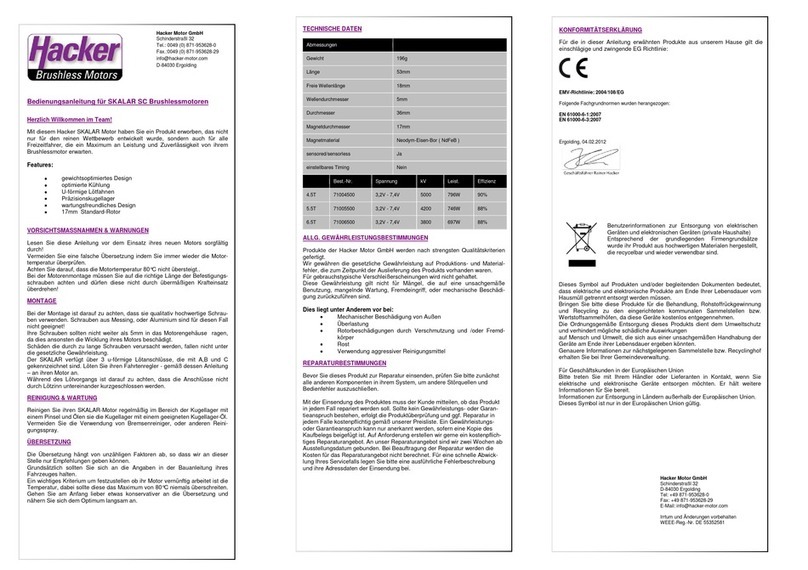
Hacker
Hacker SKALAR SC Series manual
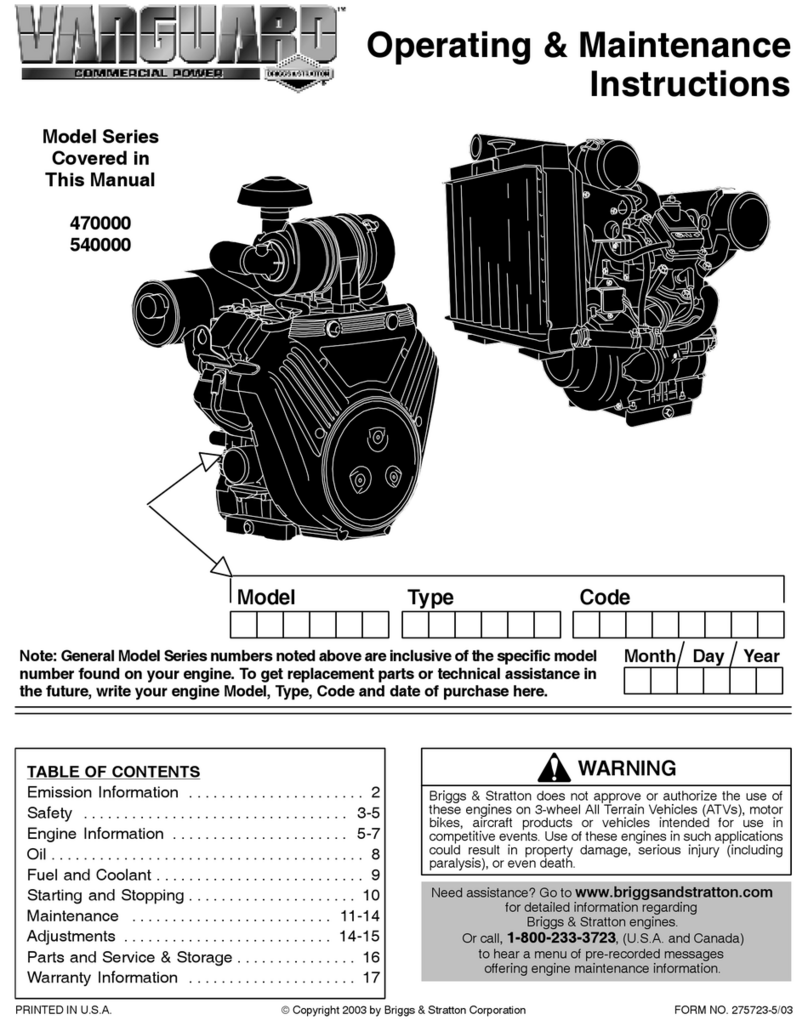
Briggs & Stratton
Briggs & Stratton Vanguard 470000 Series Operating & maintenance instructions

Volvo Penta
Volvo Penta D65A MS Workshop manual
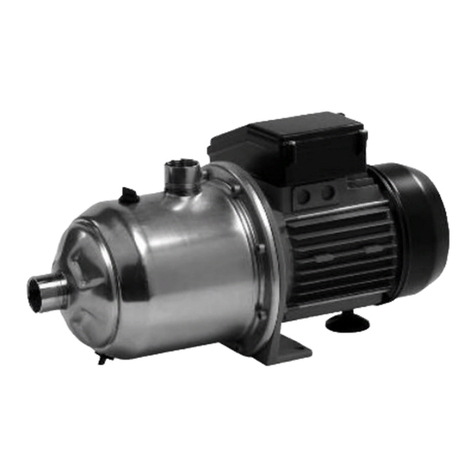
Wilo
Wilo MultiCargo MC Installation and operating instructions

Subaru
Subaru EH09-2D Service manual

Wilesco
Wilesco D100E user manual

